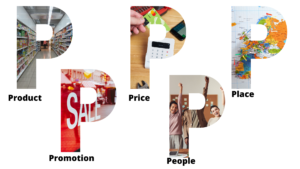The big question in many small business owners’ minds is “what is a good ROAS?”. Read on as we dissect ROAS, How to track it and why you should be tracking it.
To measure growth, digital advertisers track a variety of metrics, including conversion rate, total conversions, CTR, CPM, and CPA. Return on ad spend (ROAS) is a metric that should never be overlooked, especially in direct response advertising.
Monitoring the metric is arguably more important than ever in today’s advertising climate. This year, global digital ad spending will increase by 2.4 percent. This is the first time that growth will be in the single digits:
It’s critical to understand how advertising campaigns perform in relation to your budget. This is where the metric enters the picture.
What Is ROAS- How To Calculate It?
The total revenue generated for a specific marketing channel (such as PPC) divided by the total campaign cost on the channel is calculated as return on ad spend. More broadly, it demonstrates how effectively you’ve communicated advertising messages to the right audience; the greater the message relevance to the target audience–the greater the return on ad spend.
Calculating ROAS
For example
In one month, a company may spend $2,000 on an online advertising campaign. The campaign generates $10,000 in revenue this month. As a result, the ROAS is a 5 to 1 (or 500 percent) ratio, as $10,000 divided by $2,000 equals $5.
Every dollar spent on advertising generates $5 in revenue for the company.
Why Is Return On Ad Spend Important?
Your ROAS should be important to your team and company for a variety of reasons, including:
- Examine your ad campaigns’ average performance and financial return.
- Obtain accurate data to support ad spend increases, campaign budget changes, and other activities.
- Determine the most profitable and effective ad campaigns, ad groups, and ads.
- Obtain a benchmark average for your advertisements to compare to future calculations.
and much more
Overall, calculating your ROAS provides your company and team with information about the performance and quality of your advertising campaign. It provides you with actionable and insightful data to help you optimize your ad spend. If you skip the formula and make educated guesses about the performance of your ad campaigns, it is easy to waste your ad spend and reduce the number of leads and sales generated by advertising.
What Is A Good ROAS – Facebook, Google, Amazon & Etsy
There is no such thing as a good ROAS because each brand approaches the metric differently. A value of 4:1 is exceptional for some brands. Others would regard this as a failure. The difference between a good and a bad ROAS is determined by the profit margins of the offered product or service, the industry, and the advertising channel.
A high-profit margin demonstrates that you can afford a low return on ad spend. A small margin, on the other hand, indicates that you must keep advertising costs low in order to achieve a higher return on ad spend.
Return on ad spend varies across industries and channels in the same way that conversion rates do.
Advertisers struggle to reach audiences with meaningful content, according to available conversion data. This has an effect on the metric as well. The average conversion rate for Google Ads users across all industries is 4.40 percent for search and 0.57 percent for display, respectively:
What Is A Good ROAS for Google Ad
What Is A Good ROAS For Facebook Ad
The figures for Facebook are higher, at 9.21%
The conversion rate of your campaign can help you predict the value of your return on ad spend (ROAS). There is, however, a distinction between the metrics–conversion rate measures action rather than revenue in dollars.
What Is A Good ROAS On Amazon
Unlike Facebook and Google, Amazon follows ACOS ( advertising cost of sale) which measures the same thing as ROAS but reversed (the numerator and denominator change places).
Using our previous example
$2000/$10,000 = 20%
What Is Considered A Good ACOS On Amazon
It is determined by your profit margin; there is no one-size-fits-all figure. 2x ACos may be ideal for one brand but disastrous for another.
If your profit margin is low, you’ll need a higher ACOS for your ads to be profitable. If you have a product with a high-profit margin, you can make a profit with a lower ACOS.
Finding out your “minimum ACOS is a good way to figure out the ideal ACOS for your product. Once you have this figure, you’ll be able to tell whether or not your campaigns are profitable.
How to Calculate Your Minimum ACOS
Calculate your break-even point to determine your minimum ACOS. Your break-even point is the amount of money you make from a sale after deducting your cost of goods sold (COGS), which includes expenses like unit cost, shipping fees, supply costs, and Amazon fees. Your gross profit before advertising expenses is your break-even point.
Let’s look at a simple example:
Product cost: $30 COGS: $10
Amazon fees are $10.
profit= $10
Remember that your profit is $10 before you spend any money on advertising. If you can make a sale without advertising, that’s fantastic! You’ve made a $10 profit. However, if you need to advertise in order to make a sale, this $10 figure represents your break-even point.
If your advertising cost is $5 for one sale, your net profit is $5. If your advertising cost is $10 for one sale, you have simply “broken even,” as your profit is $0. You didn’t make or lose money on the sale.
Now that we’ve determined your break-even point, let’s calculate your minimum ACOS.
Follow this simple formula to determine your minimum RoAS:
Minimum ACOS = Sale price / Break-even point
Continuing with the previous example:
$30 / $10 = 3
This means that your minimum ACOS is 3X. So, for every dollar spent on advertising, you must generate at least $3 in revenue in order for your ads to be profitable.
For example, in my own business, anything above the minimum ACOS is considered good because it means my ads are running profitably. Even if the advertisements are barely profitable, that doesn’t mean my business isn’t. If the keywords I target convert into sales, this improves organic keyword rankings, thereby increasing organic sales.
This works well for me because my company has a very low overhead. As long as the ads are profitable, I can work on optimizing the campaigns to make them even more profitable.
On the other hand, a seller with a minimum RoAS of 3 may regard anything less than 5 as bad because it is not profitable enough for their business. Their company may have higher overhead costs such as office and warehouse rent, employee salaries, and utility bills.
This demonstrates that what works for one Amazon seller may not work for another.
What Is A Good ROAS On ETSY
ROAS varies greatly by industry, but 2.8 ROAS is a common benchmark. To learn more about performance metric calculations, read Understanding Your Ads Performance.
To calculate your current ROAS average in order to create a custom benchmark, take your total revenue over the last 30 days and divide it by your total cost.
It’s simple to make optimization adjustments based on the ROAS range you’re seeing across your listings, such as the following:
Spend your money wisely: Stop spending on items that aren’t performing (based on your current ROAS average, calculated above using your 30-day total revenue/total cost) and invest in listings that are generating more views and sales.
Seasonally change things up: Consider how interest in each item varies with the seasons, and adjust which listings are promoted to appeal to relevant shoppers.
Boost new products: If you have other listings you want to test (say, an exciting new product line), you can redirect the budget you were spending on the less-than-stellar listings to advertising the new listings to see how shoppers respond.
What Is Good ROAS For E-commerce
To begin with, according to Nielsen statistics, the average ROAS across all industries is approximately $2.87.
Take this ROAS with a grain of salt, as it is calculated using data from a wide range of industries. To date, no eCommerce-specific ROAS data has been published.
Most people consider a ROAS of 4x or 400 percent to be a “good” ROAS.
When you generate $4 for every $1 spent on ads, you have a nice buffer, and your ads are likely to turn a profit.
However, you must consider ROAS (and figure out what works for you) in the context of your profit margins, operating expenses, and marketing objectives and goals.
Assume you’re a startup that has just received $500,000 in funding and is launching a new product that is unlike anything else on the market.
Because your goal, in this case, is to educate people about your product and raise awareness, your strategy would not be to optimize for a 4x ROAS.
After all, you’re attempting to educate consumers about a new product, not expecting conversions right away.
In this case (and given that money isn’t an issue! ), we’d say you can settle for 1x or 2x ROAS on your first few campaigns.
Work on achieving that 4x ROAS once people become more familiar with your product and you move into the next phase of your marketing plan (where the goal is to drive actual sales).
Aside from marketing objectives, you must also consider your profit margin.
If you’re selling $10 phone cases drop-shipped from China and your margin is razor-thin, it’s critical that you keep your advertising costs low.
In that case, a higher ROAS is preferable.
However, if you’re selling expensive electronics with a high margin, you can live with a lower ROAS.
What Factors Influence a Good ROAS?
For businesses to generate a good ROAS, there are a few factors to consider. Three major factors can aid in determining good expectations. These are their names:
- Brand and Category Maturity
Because the concepts of brand maturation and category maturation are similar, they can be grouped together. However, these work in tandem as factors influencing ROAS. To begin, consider whether the product or service is already well-known in the market.
Consider the use of spectacles, contact lenses, or laser eye surgery. People are already aware of it. However, if a company launches a new vitamin that aids in the restoration of nutrition lost due to smoking, this is novel. Smokers are already aware of gum, cigarette patches, and other methods of quitting. However, the introduction of a vitamin that aids in quitting as well as restoring vital nutrients will garner a lot of attention.
Such circumstances necessitate special consideration because an additional layer of education for the audience is required. As a result, new product categories and start-ups fall into a different strategy pool where the ROAS will be measured differently.
Another important factor to consider is brand awareness. Consider a company that has a retail store and a large customer base. If they start selling online, it won’t be long before the company starts making money. Using the power of brand awareness to generate new sales is a quick way to get started.
A brand new company, on the other hand, must first invest money and time in brand awareness. It will take some time for such a company to generate a high-converting digital marketing program. Furthermore, a company must first work on establishing credibility and trust in the market.
A brand’s maturity equates to a faster steady-state ROAS.
As previously stated, the more mature a brand is, the easier it is for a company to achieve the initial stages of a consistent ROAS. In addition, start-ups must consider other costs for establishing a brand name and image. Visual brand identity, strategy, and brand tone will consume the majority of the marketing and advertising budget.
Other expenses include the creation of an effective website and the establishment of an office, which includes the purchase of property and furniture. Furthermore, other aspects of the digital marketing strategy will necessitate time and money. It is difficult to directly measure ROIs on these investment fronts in such cases. Whatever the cost, it is critical for properly positioning the brand and maximizing conversions. That being said, let us now turn our attention to the second factor.
- A Strong Brand That Is Conversion Optimized
A strong brand, an innovative product, and an eye-catching website all contribute to conversion. These three things can be combined to generate more leads or even more sales! However, the question remains: is your brand interesting enough? Have you created an engaging website that keeps your visitors interested all the way to the end?
This simply means that an unimpressive website can render all marketing efforts ineffective. Even the most well-targeted advertising campaigns can result in the loss of potential customers. The reason for this is a clumsy website. A good, clean website instills trust in the customer.
For first-time visitors to your website, user experience is critical. Customers can be irritated by things like a complicated navigation structure. Furthermore, unclear language and payment systems can result in lower conversion rates. The inquiry system is also crucial to the user
experience. Similarly, having appealing images or motion graphics that do not clutter the website can help to reduce bounce rates significantly
- Purchase Price and Product Lifecycle
This is the single most important factor in determining a good ROAS. The average purchase price and product lifecycle, which is the frequency with which each purchase is made. Consider a fitness brand that sells nutrition bars for $5.50. This business would necessitate frequent purchases, and the ROAS would be calculated based on bulk sales.
However, an eyeglasses business with each piece priced at $150 can quickly achieve a good ROAS. Although sales in an eyeglasses business would be less frequent, they would still be sufficient to calculate a good ROAS. The business’s lifecycle would be different, and ROAS would be calculated differently depending on the life of the business. The upfront ROAS can be used to determine the feasibility of a business.
ROI vs ROAS
ROI calculates the profit generated by ads in relation to the cost of those advertisements. The metric assesses how ads contribute to a company’s bottom line. To compute:
ROI = profits – costs x 100 / costs
While ROAS accounts for the gross revenue generated for every dollar spent on advertising, ROI accounts for the amount earned after expenses are deducted. The sole purpose of ROI is to determine whether or not a campaign is worthwhile. You can calculate the metric and assess overall profits by taking the margin into account.
ROI is important to track campaign performance, but it is not a panacea. It will not assist you in determining whether or not a campaign will be successful. Meanwhile, ROAS does more than just calculate potential profitability; it also aids in the identification of campaigns that are generating sales.
To evaluate overall campaign performance, combine ROAS with CPL (cost per lead) or CPA (cost per acquisition) goals, which account for traffic and lead quality.
To evaluate overall campaign performance, combine ROAS with CPL (cost per lead) or CPA (cost per acquisition) goals, which account for traffic and lead quality.
For example, if your CPL is low and your ROAS is low, you know you’re not generating quality leads. If you have a high CPL but a low ROAS, it means you’re not wasting time on unqualified leads, and the CPL goal can be raised.
The bottom line is that the higher the ROAS, the better.
8 Tips To Improve Your ROAS
Businesses are constantly looking for ways to improve the returns on their investments. Everything, whether it’s the ROIs or the ROAS, can be optimized and maximized by following a few simple guidelines. Here are the best methods for increasing your ROAS.
- Improved Mobile-Friendly Website
This should be self-explanatory. As more people use their smartphones to access websites and social media, your website must be mobile-friendly. It is not enough to have appealing advertisements for your product or service. All marketing efforts would be futile if a website did not function properly on a mobile device. If you want to increase conversion rates, look for ways to improve load times, improve the shopping experience, and make it more convenient for users overall.
- Targeted Keyword Refinement
The significance of keywords cannot be overstated! A higher conversion rate would result from refining the keywords to target an audience. Long-tail keywords that attract high-quality traffic can be used to optimize product pages. You can narrow down targeted keywords by using keyword discovery tools and Google trends. Use a laser targeted audience for your Facebook ads. Here’s how to research profitable Facebook ads interests for your business.
- Make use of Geo-Targeting.
Geo-targeting allows you to target customers who are physically present in a specific location. Use geo-targeting if you have a physical retail store and want to make online sales. As a result, your audience will only come from areas where you can easily deliver. This allows you to pay for relevant clicks. No company wants to pay for something that will not yield any results. Similarly, if your company only ships to certain countries, this tool can help you target customers from those countries.
4. Monitor your competitors
Spying on competitors can yield beneficial results. This can also assist you in identifying the appropriate keywords, the company’s ranking, and the advertising strategies they employ. It does not imply that you are cheating or imitating what your competitors are doing. This will only help you broaden your horizons and create effective campaigns.
- Landing Page Optimization
Obtaining clicks is only half the battle. What you require is an eye-catching landing page that leads to higher conversion rates and lower bounce rates. The landing page should correspond to the ad copy; for example, if you show an ad for red-rimmed eyeglasses, the landing page should direct visitors to the same eyeglasses. Being directed to a webpage that does not contain the same product or service as the one requested can result in a dissatisfied customer.
- Make use of Conversion Rate Optimization (CRO)
The only way to ensure that visitors become customers is to incorporate CRO into every campaign. The global cart abandonment rate of e-commerce businesses is a startling 75.6 percent! Optimizing the conversion path from beginning to end would reduce the cart abandonment rate of your company’s website.
- Seasonal Offer Promotion
The ad copy should change with the seasons and never remain static on one topic. Ad copy that is tailored to the holiday season and other events will result in higher conversion rates. This perfectly positions your product or service for customers looking for specific needs.
- Making Use of Product Listing Ads (PLAs)
When a searcher uses high-intent keywords, PLAs appear in the results. It appears as a list of product images that are linked to the search results of the page. According to one study, PLAs have increased by up to 52% in the last year. The increase in mobile PLAs was approximately 164 percent, which directly improved the ROAS by 23 percent. To create an effective PLA, the product description must be appropriate and include the appropriate keywords.
9. Use Target ROAS ad objective by Google
Target ROAS is a Google Ads bid strategy that aims to achieve the advertiser’s specified target return on ad spend.








